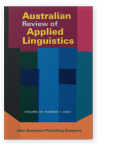Vol. 46:1 (2023) ► pp.29–53
Understanding textual meaning-making in Chinese high school EFL learners’ writing
A systemic functional perspective
The present study examines the ways Chinese high school EFL learners organize information in their writing. A class of 50 students at grade 9 from a local high school in Guangzhou, China, were recruited as participants. The students’ writing at grade 9 was collected as a corpus, comprising ten writing tasks from different text types. In order to gain a holistic understanding of the organization of information in student writing, the analytical framework of Theme at three levels – that is, clause, paragraph, and text – from Derewianka and Jones (2010) was adopted. Findings show that the students have varying degrees of control over information organization at different levels. In particular, the students are not proficient in organizing information at the paragraph level. Findings also show that registerial differences affect the organization of information. The study provides relevant pedagogical implications and recommendations for this group of learners.
Article outline
- 1.Introduction
- 2.Literature review
- 2.1Textual meaning making and L2 writing studies
- 2.2Theme and information flow in writing studies
- 3.Methodology
- 3.1Research questions
- 3.2Analytical framework
- 3.2.1Theme at the clause level
- Three types of Theme (Halliday & Matthiessen, 2014)
- Unmarked and marked Theme
- 3.2.2Paragraph level: Thematic progression patterns
- 1.Linear TP
- 2.Constant TP
- 3.Derived TP
- 4.Mixed
- 3.2.3Text level: Macro and hyper Theme
- 3.2.1Theme at the clause level
- 3.3Participants
- 3.4Data
- 4.Results and findings
- 4.1Choice of clausal Theme
- 4.1.1Topical Theme
- 4.1.2Multiple and simple Theme
- 4.1.3Marked Theme
- 4.2Thematic progression patterns
- 4.3Macro-Theme and hyper-Theme
- 4.4Summary of the findings
- 4.1Choice of clausal Theme
- 5.Discussion
- 5.1Theme as an element in illustrating registerial difference
- 5.2Theme as an enabling resource
- 5.3Theme as an indicator of language proficiency
- 6.Conclusions and implications
- 7.Limitations and further research
- Notes
-
References
